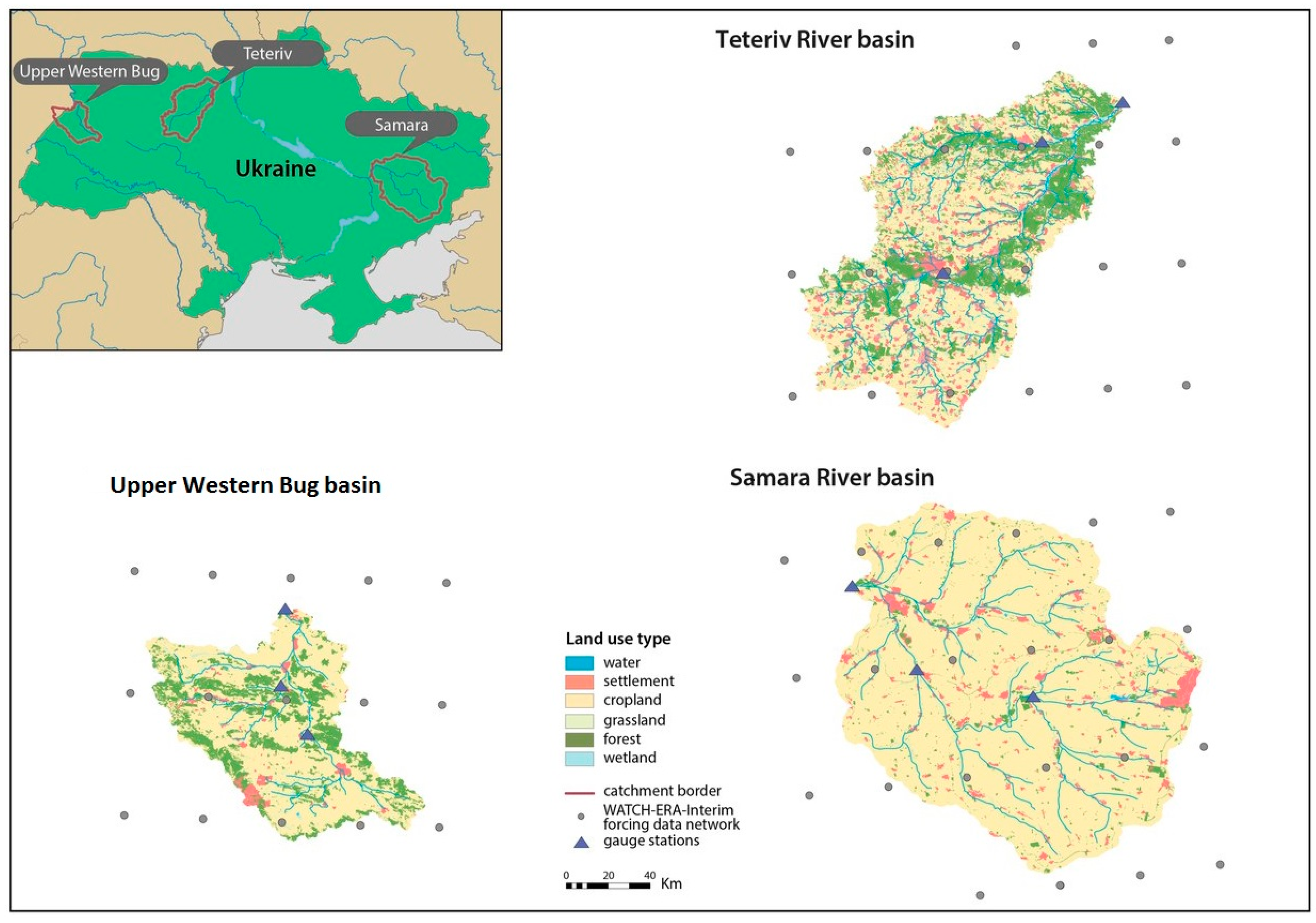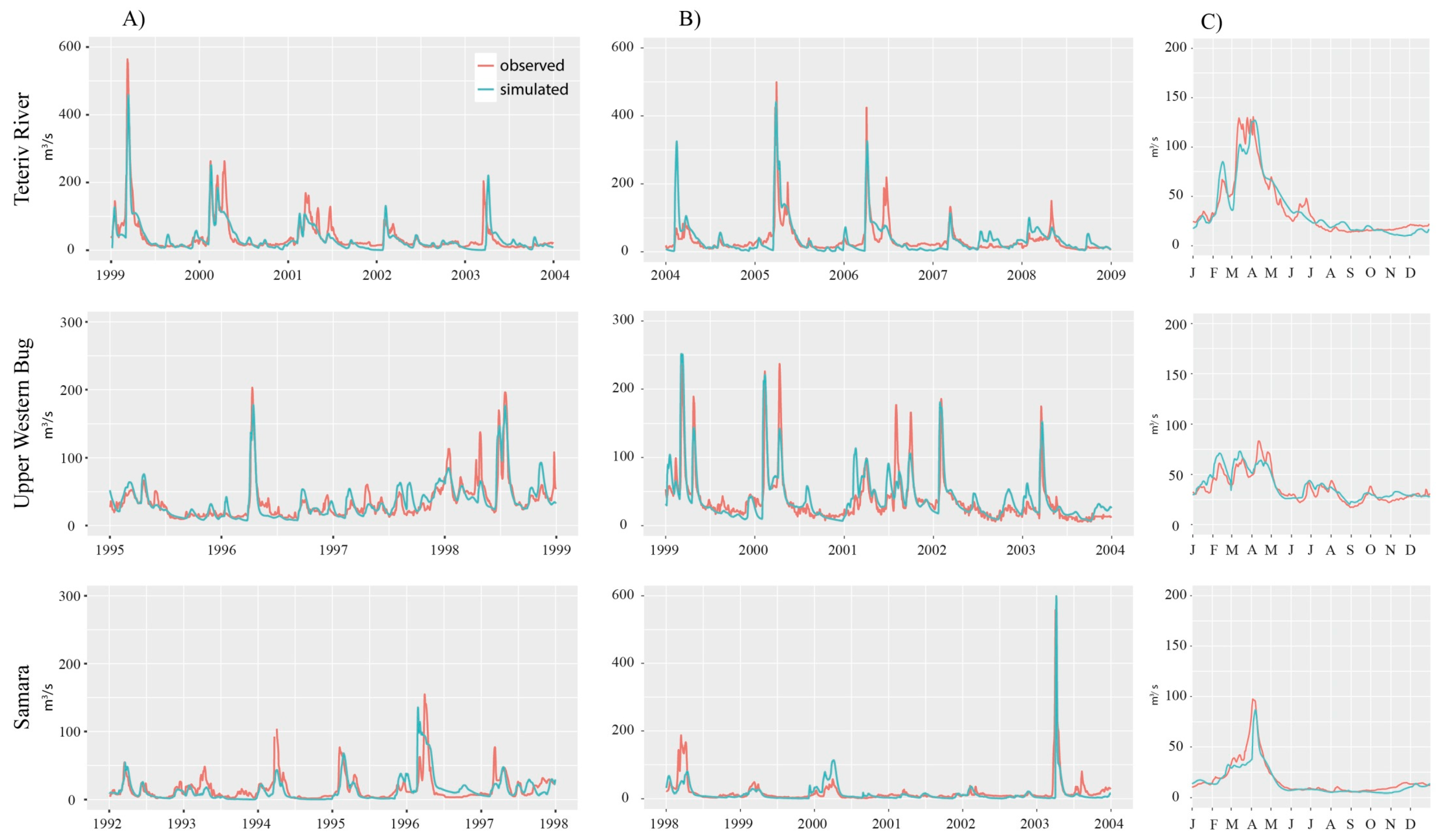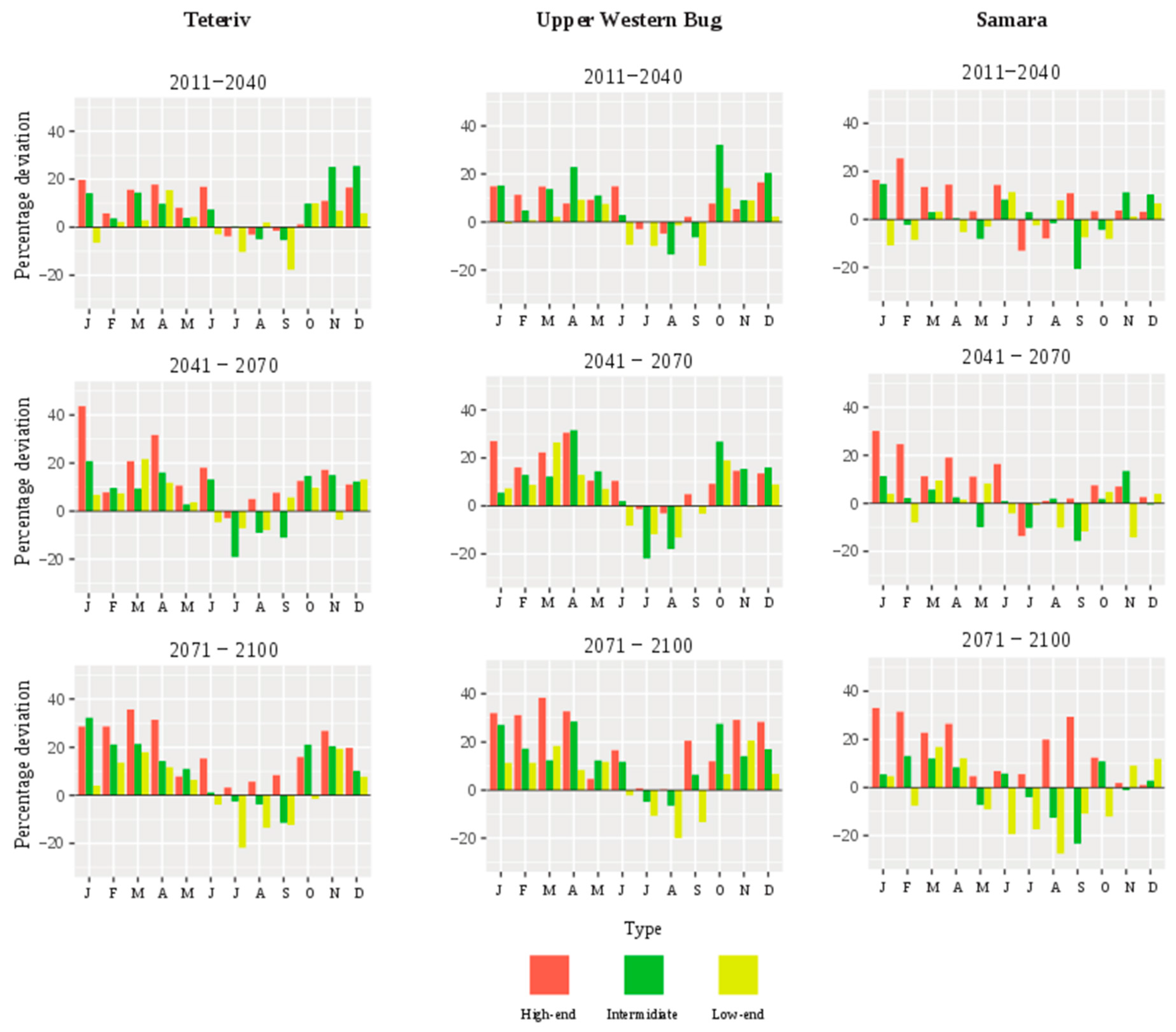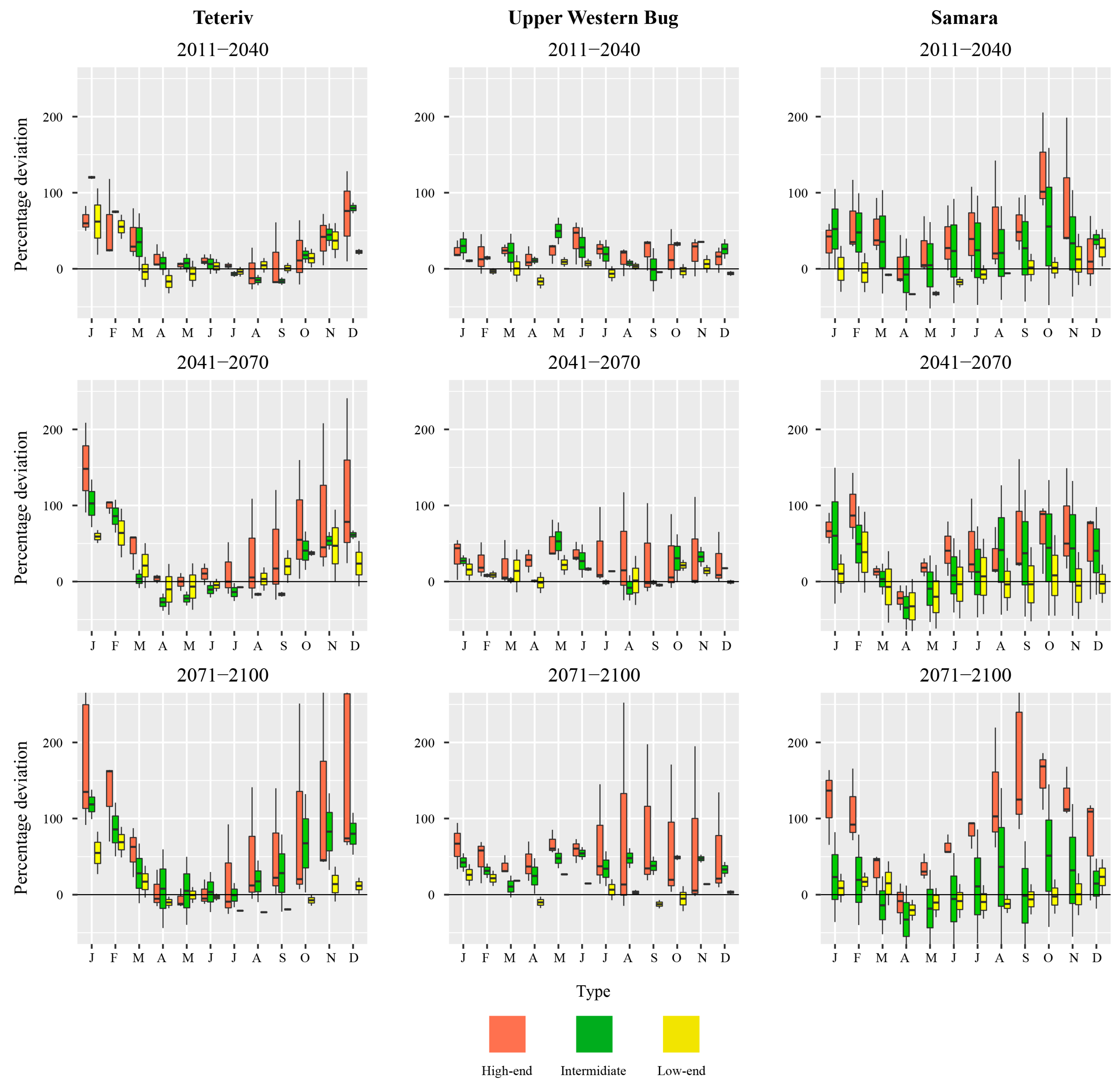Assessment of Climate Change Impacts on Water Resources in Three Representative Ukrainian Catchments Using Eco-Hydrological Modelling
Abstract
:1. Introduction
2. Materials and Methods
2.1. Study Area
2.2. SWIM Model Description
2.3. Input Data
2.4. Model Setup, Calibration, and Validation
2.5. Climate Scenarios
3. Results
3.1. Model Performance
3.2. Assessment of Expected Climate Change Impacts
4. Discussion
5. Conclusions
Acknowledgments
Author Contributions
Conflicts of Interest
References
- Bates, B.C.; Kundxewicz, Z.W.; Wu, S.; Palutikof, J.P. Climate Change and Water; Technical Paper of the Intergovernmental Panel on Climate Change; IPCC Secretariat: Geneva, Switzerland, 2008. [Google Scholar]
- Kovats, R.S.; Valentini, R.; Bouwer, L.M.; Georgopoulou, E.; Jacob, D.; Martin, E.; Rounsevell, M.; Soussana, J. Climate Change 2014: Impacts, Adaptation, and Vulnerability. Part B: Regional Aspects. Contribution of Working Group II to the Fifth Assessment Report of the Intergovernmental Panel on Climate Change; Cambridge Univ. Press: Cambridge, UK, 2014; pp. 1267–1326. [Google Scholar]
- Vormoor, K.; Lawrence, D.; Heistermann, M.; Bronstert, A. Climate change impacts on the seasonality and generation processes of floods—Projections and uncertainties for catchments with mixed snowmelt/rainfall regimes. Hydrol. Earth Syst. Sci. 2015, 19, 913–931. [Google Scholar] [CrossRef]
- Cisneros, J.; Oki, T.; Arnell, N.W.; Benito, G.; Cogley, J.G.; Döll, P.; Jiang, T.; Mwakalila, S.S. Climate Change 2014: Impacts, Adaptation, and Vulnerability. Part A: Global and Sectoral Aspects. Contribution of Working Group II to the Fifth Assessment Report of the Intergovernmental Panel on Climate Change; Cambridge Univ. Press: Cambridge, UK, 2014; pp. 229–269. [Google Scholar]
- European Commission The EU Water Framework Directive—Integrated River Basin Management for Europe. Available online: http://ec.europa.eu/environment/water/water-framework/index_en.html (accessed on 3 November 2016).
- The World Bank Group. Renewable Internal Freshwater Resources per Capita (Cubic Meters). Available online: http://data.worldbank.org/indicator/ER.H2O.INTR.PC (accessed on 5 May 2016).
- Snizhko, I.; Kuprikov, O.; Shevchenko, P.; Evgen, I.D. Use of Water-Balance Turk Model and Numerical Regional Model REMO for Assessment of Local Water Resources Runoff in Ukraine in the XXI Century; Bryansk State Univ. Her.: Bryansk, Russia, 2014; pp. 191–201. (In Russian) [Google Scholar]
- Buksha, I.; Gozhik, P.; Iemekianova, Z.; Trifimova, I.; Shereshevskiy, A. Ukraine and Global Greenhouse Effect. Book 2. Vulnerability and Adaptation Ecological and Economical Systems to Climate Change; Agency for Rational Energy and Ecology Use: Kyiv, Ukraine, 1998. (In Ukrainian) [Google Scholar]
- Loboda, N.; Serbova, Z. Modelling of Climate Changre Impact on the Rivers Flow of Ukraine. Impact Clim. Chang. Econ. Ukr. 2015, 1, 451–482. (In Ukrainian) [Google Scholar]
- Bär, R.; Rouholahnejad, E.; Rahman, K.; Abbaspour, K.C.; Lehmann, A. Climate change and agricultural water resources: A vulnerability assessment of the Black Sea catchment. Environ. Sci. Policy 2015, 46, 57–69. [Google Scholar] [CrossRef]
- Fischer, S.; Pluntke, T.; Pavlik, D.; Bernhofer, C. Hydrologic effects of climate change in a sub-basin of the Western Bug River, Western Ukraine. Environ. Earth Sci. 2014, 72, 4727–4744. [Google Scholar] [CrossRef]
- Schneider, C.; Laizé, C.L.R.; Acreman, M.C.; Flörke, M. How will climate change modify river flow regimes in Europe? Hydrol. Earth Syst. Sci 2013, 17, 325–339. [Google Scholar] [CrossRef] [Green Version]
- Hesse, C.; Stefanova, A.; Krysanova, V. Comparison of Water Flows in Four European Lagoon Catchments under a Set of Future Climate Scenarios. Water 2015, 7, 716–746. [Google Scholar] [CrossRef]
- Pluntke, T.; Barfus, K.; Myknovych, A.; Bernhofer, K. Hydrologic Effects of Climate Change in the Western Bug Basin. In Proceedings of the Global and Regional Climate Changes, Kyiv, Ukraine, 16–19 November 2010.
- Pluntke, T.; Pavlik, D.; Bernhofer, C. Reducing uncertainty in hydrological modelling in a data sparse region. Environ. Earth Sci. 2014, 72, 4801–4816. [Google Scholar] [CrossRef]
- Tavares Wahren, F.; Helm, B.; Schumacher, F.; Pluntke, T.; Feger, K.-H.; Schwärzel, K. A modeling framework to assess water and nitrate balances in the Western Bug river basin, Ukraine. Adv. Geosci. 2012, 32, 85–92. [Google Scholar] [CrossRef] [Green Version]
- Snizhko, S.; Yazuk, M.; Kuprikov, I.; Shevchenko, O.; Strutinska, V.; Krakovska, S.; Palamarchuk, L.; Shedemenko, I. Assessment of possible water resources changes of local runoff in Ukraine in XXI century. Water Econ. Ukr. 2012, 6, 5–20. (In Ukrainian) [Google Scholar]
- Krysanova, V.; Wechsung, F.; Arnold, J.; Ragavan, S.; Williams, J. SWIM (Soil and Water Integrated Model), User Manual; PIK Report Nr. 69: Potsdam, Germany, 2000. [Google Scholar]
- Ukraine—Water Management. Available online: http://www.fao.org/countryprofiles/index/en/?iso3=UKR&paia=4 (accessed on 2 November 2016).
- AQUASTAT—FAO’s Information System on Water and Agriculture. Available online: http://www.fao.org/nr/water/aquastat/countries_regions/UKR/index.stm (accessed on 3 September 2016).
- Eurostat. Available online: http://ec.europa.eu/eurostat (accessed on 3 September 2016).
- Snizhko, S. Wasserwirtschaftliche und ökologische Situation im Dnipro—Einzugsgebiet. Hydrol. Wasserbewirtsch. 2001, 1, 2–8. [Google Scholar]
- Climate Cadastre of Ukraine; Ukrainian Hydrometeorological Center: Kyiv, Ukraine, 2006. (In Ukrainian)
- Ukrainian Hydrometeorological Center. Available online: http://meteo.gov.ua/en/ (accessed on 12 September 2015).
- Regional Report on the State of the Environment in Zhytomyr Region in 2014; Department of Ecology and Natural resources of Zhytomyr Regional State Administration: Zhytomyr, Ukraine, 2015. (In Ukrainian)
- Regional Report on the State of the Environment in Lviv Region in 2014; Department of Ecology and Natural resources of Lviv Regional State Administration: Lviv, Ukraine, 2015. (In Ukrainian)
- Regional Report on the State of the Environment in Dnipropetrovsk Region in 2014; Department of Ecology and Natural resources of Dnipropetrovsk Regional State Administration: Dnipropetrovsk, Ukraine, 2015. (In Ukrainian)
- Arnold, J.G.; Fohrer, N. SWAT2000: Current capabilities and research opportunities in applied watershed modelling. Hydrol. Process. 2005, 19, 563–572. [Google Scholar] [CrossRef]
- Krysanova, V.; Meiner, A.; Roosaare, J.; Vasilyev, A. Simulation modelling of the coastal waters pollution from agricultural watersched. Ecol. Model. 1989, 49, 7–29. [Google Scholar] [CrossRef]
- Arnold, J.; Williams, J.; Nicks, A.; Sammons, N. SWRRB–A Basin Scale Simulation Model for Soil and Water Resources Management; Texas A&M University Press: College Station, TX, USA, 1990. [Google Scholar]
- Williams, J.R.; Renard, K.G.; Dyke, P.T. EPIC—A new model for assessing erosion’s effect on soil productivity. J. Soil Water Conserv. 1984, 38, 381–383. [Google Scholar]
- Hattermann, F.F.; Post, J.; Krysanova, V.; Conradt, T.; Wechsung, F. Assessment of Water Availability in a Central-European River Basin (Elbe) under Climate Change. Adv. Clim. Chang. Res. 2008, 4, 42–50. [Google Scholar]
- Huang, S.; Krysanova, V.; Zhai, J.; Su, B. Impact of Intensive Irrigation Activities on River Discharge Under Agricultural Scenarios in the Semi-Arid Aksu River Basin, Northwest China. Water Resour. Manag. 2014, 29, 945–959. [Google Scholar] [CrossRef]
- Aich, V.; Liersch, S.; Vetter, T.; Huang, S.; Tecklenburg, J.; Hoffmann, P.; Koch, H.; Fournet, S.; Krysanova, V.; Müller, E.N.; et al. Comparing impacts of climate change on streamflow in four large African river basins. Hydrol. Earth Syst. Sci. 2014, 18, 1305–1321. [Google Scholar] [CrossRef] [Green Version]
- Stagl, J.; Hattermann, F. Impacts of Climate Change on the Hydrological Regime of the Danube River and Its Tributaries Using an Ensemble of Climate Scenarios. Water 2015, 7, 6139–6172. [Google Scholar] [CrossRef]
- Lobanova, A.; Stagl, J.; Vetter, T.; Hattermann, F. Discharge alterations of the Mures River, Romania under ensembles of future climate projections and sequential threats to aquatic ecosystem by the end of the century. Water 2015, 7, 2753–2770. [Google Scholar] [CrossRef]
- Krysanova, V.; Hattermann, F.; Huang, S.; Hesse, C.; Vetter, T.; Liersch, S.; Koch, H.; Kundzewicz, Z.W. Modelling climate and land-use change impacts with SWIM: Lessons learnt from multiple applications. Hydrol. Sci. J. 2015, 60, 606–635. [Google Scholar] [CrossRef]
- CGIAR-CSI SRTM 90m DEM Digital Elevation Database. Available online: http://srtm.csi.cgiar.org/ (accessed on 5 November 2015).
- OpenStreetMap. Available online: https://www.openstreetmap.org/#map=5/47.739/16.040 (accessed on 7 November 2015).
- Natural Earth. Available online: http://www.naturalearthdata.com/ (accessed on 7 November 2015).
- USGS Global Visualization Viewer. Available online: http://glovis.usgs.gov/ (accessed on 8 October 2015).
- Landsat 5 History. Available online: http://landsat.usgs.gov/about_landsat5.php (accessed on 7 November 2015).
- FAO/IIASA/ISRIC/ISSCAS/JRC Harmonized World Soil Database. Available online: http://webarchive.iiasa.ac.at/Research/LUC/External-World-soil-database/HTML/index.html?sb=1 (accessed on 15 November 2015).
- Wosten, J.; Pachepsky, Y.A.; Rawls, W.J. Pedotransfer functions: Bridging the gap between available basic soil data and missing soil hydraulic characteristics. J. Hydrol. 2001, 251, 123–150. [Google Scholar] [CrossRef]
- Weedon, G.P.; Gomes, S.; Viterbo, P.; Shuttleworth, W.J.; Blyth, E.; Österle, H.; Adam, J.C.; Bellouin, N.; Boucher, O.; Best, M. Creation of the WATCH Forcing Data and Its Use to Assess Global and Regional Reference Crop Evaporation over Land during the Twentieth Century. J. Hydrometeorol. 2011, 12, 823–848. [Google Scholar] [CrossRef]
- Weedon, G.P.; Gomes, S.; Viterbo, P.; Österle, H.; Adam, J.C.; Bellouin, N.; Boucher, O.; Best, M. The Watch Forcing Data 1958–2001: A Meteorological Forcing Dataset for Land Surface-and Hydrological-Models; WATCH Technical Report: Exeter, UK, 2010; p. 41. [Google Scholar]
- Weedon, G.P.; Balsamo, G.; Bellouin, N.; Gomes, S.; Best, M.J.; Viterbo, P. Data methodology applied to ERA-Interim reanalysis data. Water Resour. Res. 2014, 50, 7505–7514. [Google Scholar] [CrossRef]
- Nash, J.E.; Sutcliffe, J.V. River Flow Forecasting Through Conceptual Models Part I—A Discussion of Principles. J. Hydrol. 1970, 10, 282–290. [Google Scholar] [CrossRef]
- Moriasi, D.N.; Arnold, J.G.; Van Liew, M.W.; Binger, R.L.; Harmel, R.D.; Veith, T.L. Model evaluation guidelines for systematic quantification of accuracy in watershed simulations. Trans. ASABE 2007, 50, 885–900. [Google Scholar] [CrossRef]
- Gupta, H.V.; Sorooshian, S.; Yapo, P.O. Status of Automatic Calibration for Hydrologic Models: Comparison with Multilevel Expert Calibration. J. Hydrol. Eng. 1999, 4, 135–143. [Google Scholar] [CrossRef]
- Impacts and Risks from High-End Scenarios: Strategies for Innovative Solutions. Available online: http://www.impressions-project.eu/ (accessed on 18 January 2016).
- Kok, K.; Christensen, J.H.; Madsen, M.S.; Pedde, S.; Gramberger, M.; Jäger, J.; Carter, T. Evaluation of Existing Climate and Socio-Economic Scenarios Including a Detailed Description of the Final Selection. Available online: http://impressions-project.eu/getatt.php?filename=attachme_12294.t (accessed on 15 February 2017).
- Gudmundsson, L.; Bremnes, J.B.; Haugen, J.E.; Engen-Skaugen, T. Technical Note: Downscaling RCM precipitation to the station scale using statistical transformations—A comparison of methods. Hydrol. Earth Syst. Sci. 2012, 16, 3383–3390. [Google Scholar] [CrossRef]
- Räty, O.; Räisänen, J.; Ylhäisi, J.S. Evaluation of delta change and bias correction methods for future daily precipitation: Intermodel cross-validation using ENSEMBLES simulations. Clim. Dyn. 2014, 42, 2287–2303. [Google Scholar] [CrossRef]
- Čerkasova, N.; Ertürk, A.; Zemlys, P.; Denisov, V.; Umgiesser, G. Curonian Lagoon drainage basin modelling and assessment of climate change impact. Oceanologia 2016, 58, 90–102. [Google Scholar] [CrossRef]




| Teteriv | Samara | Western Bug | |
|---|---|---|---|
| Total drainage area, km2 | 15,100 | 22,600 | 39,420 |
| Drainage area considered in the modelling, km2 | 12,400 | 19,800 | 6,750 |
| Gauging stations | Ivankiv, | Kocherizhki, | Lytovezh, |
| Ukrainka, | Grushevskiy, | Mezhirichya, | |
| Zhitomir | Vasilkovka | Kamenka-Bugskaya | |
| Major tributaries | Irsha, Guyva, Gnulopyat | Vovcha, Kilchen, Buk, Veluka Ternivka | Luga, Rata, Solokia |
| Q, m3/s | 33.8 | 14.8 | 34.2 |
| P, mm | 621 | 535 | 682 |
| T, °C | 7.0 | 8.2 | 7.4 |
| Runoff coefficient (RC) | 0.14 | 0.04 | 0.23 |
| Major land use types | Cropland 53% | Cropland 75% | Cropland 67% |
| Forest 24% | Forest 13% | Forest 24.8% | |
| Settlements 12% | Settlements 7% | Settlements 4% |
| Catchment | Period | T, °C | ΔT, °C | P, mm | ΔP, mm | Q, mm | ΔQ, mm | ||||||||||||
|---|---|---|---|---|---|---|---|---|---|---|---|---|---|---|---|---|---|---|---|
| L | I | H | L | I | H | L | I | H | L | I | H | L | I | H | L | I | H | ||
| Teteriv | reference | 8.2 | 8.2 | 8.2 | 658 | 666 | 664 | 79 | 84 | 79 | |||||||||
| near | 9.3 | 9.4 | 9.4 | 1.1 | 1.2 | 1.2 | 655 | 714 | 714 | −3 | 48 | 50 | 81 | 107 | 102 | −0.5 | 7.2 | 7.5 | |
| middle | 9.6 | 10.7 | 10.8 | 1.4 | 2.5 | 2.6 | 674 | 691 | 751 | 16 | 25 | 87 | 86 | 89 | 114 | 2.4 | 3.8 | 13.1 | |
| far | 9.8 | 11.4 | 12.6 | 1.6 | 3.2 | 4.3 | 654 | 695 | 765 | −4 | 29 | 101 | 81 | 107 | 119 | −0.6 | 4.4 | 15.2 | |
| Upper Western Bug | reference | 8.1 | 8.1 | 8.1 | 738 | 757 | 743 | 180 | 188 | 188 | |||||||||
| near | 9 | 9.1 | 9.2 | 0.9 | 1.1 | 1.1 | 729 | 809 | 796 | −9 | 52 | 53 | 178 | 228 | 227 | −1.2 | 7.1 | 7.1 | |
| middle | 9.4 | 10.3 | 10.5 | 1.3 | 2.3 | 2.4 | 749 | 791 | 822 | 11 | 34 | 79 | 198 | 214 | 246 | 1.5 | 10.6 | 10.6 | |
| far | 9.6 | 10.9 | 12.3 | 1.5 | 2.9 | 4.2 | 748 | 811 | 862 | 10 | 54 | 119 | 196 | 259 | 301 | 1.4 | 16 | 16 | |
| Samara | reference | 9.3 | 9.3 | 9.3 | 583 | 589 | 580 | 44 | 40 | 35 | |||||||||
| near | 10.2 | 10.4 | 10.6 | 0.9 | 1.2 | 1.3 | 577 | 598 | 619 | −6 | 9 | 39 | 40 | 49 | 48 | −1 | 1.5 | 6.7 | |
| middle | 10.7 | 11.6 | 12.2 | 1.4 | 2.3 | 2.9 | 573 | 587 | 636 | −10 | −2 | 56 | 45 | 46 | 48 | −1.7 | −0.3 | 9.7 | |
| far | 10.9 | 12.5 | 14 | 1.5 | 3.2 | 4.7 | 555 | 569 | 662 | −28 | −20 | 82 | 46 | 37 | 60 | −4.8 | −3.4 | 14.1 | |
| Catchment | Calibration | Validation | ||||||
|---|---|---|---|---|---|---|---|---|
| NSE | Pbias | NSE | Pbias | |||||
| Daily | Monthly | Daily | Monthly | Daily | Monthly | Daily | Monthly | |
| Teteriv (Ivankiv) | 0.75 | 0.82 | −10.8 | −10.5 | 0.53 | 0.57 | 9.5 | 10 |
| Upper Western Bug (Lytovezh) | 0.75 | 0.82 | 1.8 | 3.3 | 0.67 | 0.76 | 10.2 | 12 |
| Samara (Kocherezhky) | 0.42 | 0.5 | −3.9 | −11.9 | 0.58 | 0.71 | −21 | −21.3 |
© 2017 by the authors. Licensee MDPI, Basel, Switzerland. This article is an open access article distributed under the terms and conditions of the Creative Commons Attribution (CC BY) license ( http://creativecommons.org/licenses/by/4.0/).
Share and Cite
Didovets, I.; Lobanova, A.; Bronstert, A.; Snizhko, S.; Maule, C.F.; Krysanova, V. Assessment of Climate Change Impacts on Water Resources in Three Representative Ukrainian Catchments Using Eco-Hydrological Modelling. Water 2017, 9, 204. https://doi.org/10.3390/w9030204
Didovets I, Lobanova A, Bronstert A, Snizhko S, Maule CF, Krysanova V. Assessment of Climate Change Impacts on Water Resources in Three Representative Ukrainian Catchments Using Eco-Hydrological Modelling. Water. 2017; 9(3):204. https://doi.org/10.3390/w9030204
Chicago/Turabian StyleDidovets, Iulii, Anastasia Lobanova, Axel Bronstert, Sergiy Snizhko, Cathrine Fox Maule, and Valentina Krysanova. 2017. "Assessment of Climate Change Impacts on Water Resources in Three Representative Ukrainian Catchments Using Eco-Hydrological Modelling" Water 9, no. 3: 204. https://doi.org/10.3390/w9030204







